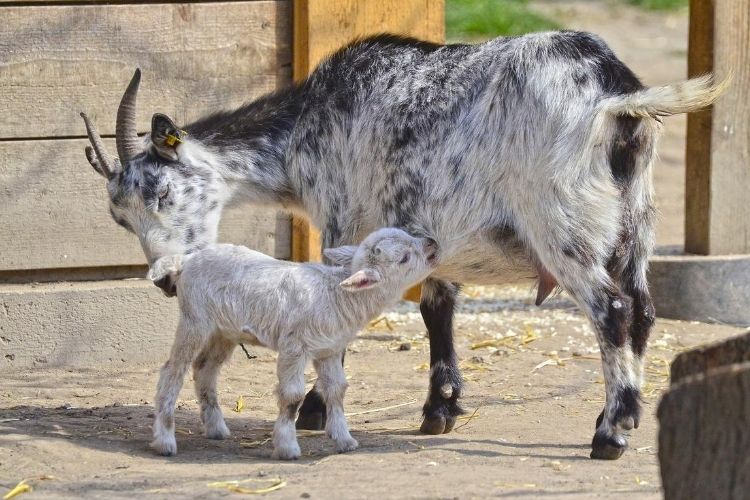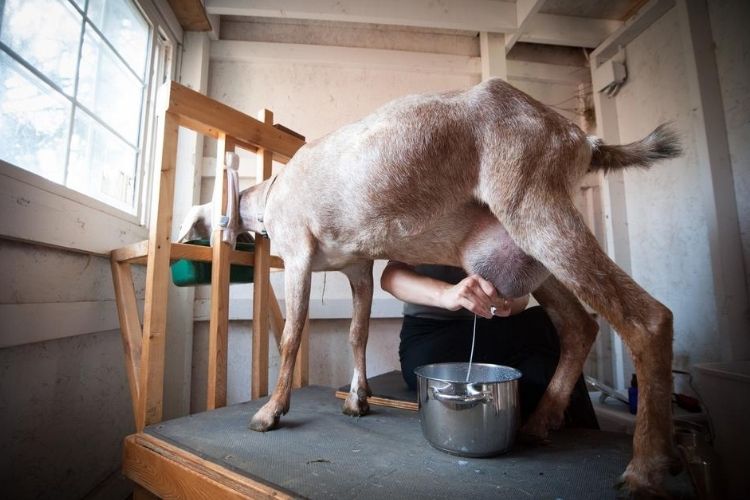Magnetic paint is a great alternative to the pinboard. It’s not only more aesthetically pleasing, but it also has stronger magnets built-in which make it easier for you to hang your pictures on the wall. Although magnetic paint may be slightly more expensive than regular paint, the convenience of having strong magnets built into your walls makes up for that difference in price!
Goat Care After Lambing
Like any animal, a goat after lambing requires special attention to itself, because this process takes a lot of energy from it.
As soon as the goat has lambed, it must be milked. This must be done even if the afterbirth has not yet come out.
The first jets should be drained into a separate bowl, but they are not given to the kids, because they have a very high content of microbes and if you give this portion to the kid, it can get sick.
The milking procedure is very important in particular for dairy breeds. If this is not done, then there is a danger of milk accumulation in the udder.
And this can lead to thickening of the mammary glands and the occurrence of mastitis. This is especially important if the kids will be fed separately.
Also, in order to milk a goat after lambing, you need to milk it at least 4 times a day.
In order for the goat to regain her strength, she needs to be given about 2 liters of water (you can add a cup of molasses there). Every 2 hours, the animal must be given this drink.
It stimulates the production of milk, and also compensates for the lack of nutrients and lack of fluid in the body.
Childbirth can be called completed if the afterbirth came out (about an hour and a half should pass). If the afterbirth does not come out, the goat should be given a flaxseed decoction.
If even then there is no placenta, then you need to seek the help of a veterinarian. The released placenta must be removed and destroyed immediately.
Next, the goat needs to be washed, in particular the back and thighs. You need to wash it with a slightly warm solution of soda (4%). After that, the animal must be left alone so that it can rest.
Feeding goats after lambing
Caring for a goat after lambing includes special nutrition. After about three hours of rest, the goat needs to be given 200-300 grams. bran or flour in liquid form. The mixture should be warm, but not very runny.
It is also advisable to give good hay, succulent types of feed, and root crops. At this stage, it is recommended to give the goat cake, carrots, it is very important to feed salt on average up to 15 grams, bone meal and chalk.
For a goat after lambing, a small slice of dark bread with butter or ghee will be useful.
Next, you can make milk soup for the animal and add a little flaxseed oil to it.
First, the goat needs to be fed watery food and, most importantly, in small doses.
If the animal needs to be milked, then it should be fed with juniper soup, silage, and various grain mixtures.
This feed has a positive effect on milk production and bowel function.
After lambing, the goat should be given easily digestible feed in small quantities for the first three days. Then they switch to a regular diet.
Concentrated feed should be excluded from feed, and simple and light feed should be provided. Give only clean water.
Milking Goats: Features, Techniques, Secrets
Is it easy to milk a goat? Experienced farmers say that this is a simple matter, although it requires skills, while beginner farmers, on the contrary, do not even know which side to approach the goat. In fact, it is more important not only to be able to milk goats – it is easy to learn it! – and doing it right, which is much more difficult.
General recommendations
One of the main conditions for successful milking of goats is compliance with sanitary standards. Washing hands before milking and using clean and disinfected tools (buckets, parts of the milking machine) – without this quality goat milk simply does not exist! Each goat must undergo a certain treatment, first of all – you need to cut the wool around the udder. This wool usually contains dirt, which can then enter the milk.
During milking, there should not be an adult goat next to the goats, otherwise the milk will acquire a specific “goat” smell, which completely spoils the product. Ideally, goats should be kept separate from goats.
Freshly obtained milk must be cooled as quickly as possible, and all gases must be removed from it. This is done in special refrigerators with aeration. During transportation, milk should not come into contact with odorous substances, otherwise it will itself acquire unwanted odors.
All of these comments are relevant to both hand and machine milking.
Hand milking
Hand milking is a traditional way of getting milk from goats. Despite its apparent simplicity, manual milking is complex, costly and not always efficient. Nowadays, only the mistresses of one or two goats are milked by hand, and farmers owning small herds – in this case, according to the norms, no more than 25 goats should fall on one milkmaid.
There are several milking techniques that can help milk your goat faster and get the most out of your goat.
Many milkmaids recommend just talking to the goat – the voice of the milkmaid, especially the one who constantly milks the goat, calms the animal and it does not resist milking. It is also recommended to give the goat some feed while she is at the pen.
Immediately before milking, it is necessary to treat the nipples with a disinfectant (for example, iodine solution), squeeze out one stream, and wipe the nipples with a dry towel. This achieves the removal of pathogens that accumulate in the ducts during the day. Also, the first streams of milk can be milked into a bucket through a fine sieve (or gauze) – this way you can visually see the signs of mastitis, which is expressed by the appearance of lumps and clots in the milk, and the milk itself can become watery.
Even before milking, you can gently pat the udder with your palm several times – this somewhat simplified imitation of a kid that attaches to the udder sets the goat to the fact that now it should give as much milk as possible.
Machine milking
Machine milking also has its own subtleties, and in some respects it is even more difficult than manual milking.
To achieve the best result, it is necessary to use milking machines designed specifically for goats, otherwise problems with milk yield and animal health are possible.
During milking, you need to monitor each teat – this can be done with special transparent inserts in the glasses. When the flow of milk into one of the glasses stops, it is necessary to bend the hose and remove it from the nipple. The kinking of the hose prevents air from being sucked in and dust, odors and bacteria from entering the milk. Ideally, special plugs should be prepared for this, with which you can plug the teat cup while the rest are still on the teats.
Machine milking requires some skill, as incorrect positioning of cups on the teats, or incorrect settings for pulsation and vacuum levels can harm the animal. So it is always necessary to monitor the equipment here, because the quality of milk, the health of the goats and, ultimately, the efficiency of the entire farm depend on its work.



